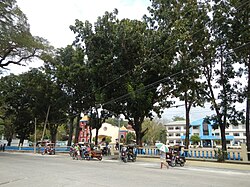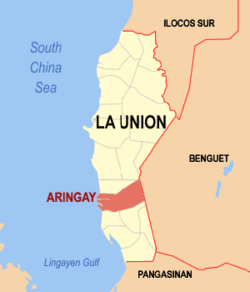This article needs additional citations for verification. (August 2013) |
Aringay | |
|---|---|
| Municipality of Aringay | |
 Aringay town center along the National Highway | |
 Map of La Union with Aringay highlighted | |
Location within the Philippines | |
| Coordinates: 16°23′54″N 120°21′20″E / 16.398208°N 120.355481°E | |
| Country | Philippines |
| Region | Ilocos Region |
| Province | La Union |
| District | 2nd district |
| Founded | 1641 |
| Barangays | 24 (see Barangays) |
| Government | |
| • Type | Sangguniang Bayan |
| • Mayor | Eric O. Sibuma |
| • Vice Mayor | Benjamin O. Sibuma |
| • Representative | Sandra Y. Eriguel |
| • Municipal Council | Members |
| • Electorate | 32,696 voters (2022) |
| Area | |
| • Total | 84.54 km2 (32.64 sq mi) |
| Elevation | 38 m (125 ft) |
| Highest elevation | 299 m (981 ft) |
| Lowest elevation | 0 m (0 ft) |
| Population (2020 census)[3] | |
| • Total | 50,380 |
| • Density | 600/km2 (1,500/sq mi) |
| • Households | 12,237 |
| Economy | |
| • Income class | 2nd municipal income class |
| • Poverty incidence | 10.75 |
| • Revenue | |
| • Assets | |
| • Expenditure | |
| • Liabilities | ₱ 58.95 million (2020) |
| Service provider | |
| • Electricity | La Union Electric Cooperative (LUELCO) |
| Time zone | UTC+8 (PST) |
| ZIP code | 2503 |
| PSGC | |
| IDD : area code | +63 (0)72 |
| Native languages | Ilocano Pangasinan Tagalog |
| Website | www |
Aringay, officially the Municipality of Aringay (Ilocano: Ili ti Aringay; Pangasinan: Baley na Aringay; Filipino: Bayan ng Aringay), is a second class municipality in the province of La Union, Philippines. According to the 2020 census, it has a population of 50,380 people.[3]
Known in Philippine History as the birthplace of revolutionary leader Diego Silang,[5] its economy is based primarily on agriculture, producing rice, tobacco and fruit crops as economic staples. A nascent tourism industry is centered on its beach resorts. Its ethnic population is predominantly Ilocano and Christian (Roman Catholic).
- ^ Municipality of Aringay | (DILG)
- ^ "2015 Census of Population, Report No. 3 – Population, Land Area, and Population Density" (PDF). Philippine Statistics Authority. Quezon City, Philippines. August 2016. ISSN 0117-1453. Archived (PDF) from the original on May 25, 2021. Retrieved July 16, 2021.
- ^ a b Census of Population (2020). "Region I (Ilocos Region)". Total Population by Province, City, Municipality and Barangay. Philippine Statistics Authority. Retrieved 8 July 2021.
- ^ "PSA Releases the 2021 City and Municipal Level Poverty Estimates". Philippine Statistics Authority. 2 April 2024. Retrieved 28 April 2024.
- ^ Guillermo, Artemio R. (2012). Historical dictionary of the Philippines (3rd ed.). Lanham, Md.: Scarecrow Press. p. 401. ISBN 978-0-8108-7511-1. OCLC 774293494.



